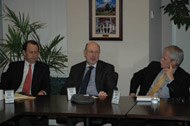|
COVER STORY, MAY 2007
CAROLINA RETAIL ROUNDTABLE
The development of Coastal communities, mixed-use projects, highlight first Carolinas Roundtable.
Moderated by Gary T. Saykaly, Randall Shearin and Chris Thorn
Because of the amazing amount of activity taking place in North Carolina and South Carolina, Southeast Real Estate Business held a developers’ roundtable before the ICSC Carolinas Idea Exchange in March. The roundtable was hosted by Childress Klein Properties at its offices in dowtown Charlotte, North Carolina. In attendance were: David P. Hill, JDH Capital; Britt Byrne, Faison & Associates; Jeff LeForce, Burroughs & Chapin Co.; Chris Hack, Crescent Resources; Brady Glenn, Centennial American Properties; Lyle Darnall, Edens & Avant; Robert H. Spratt, Jr., Hill Partners; Chris Thomas, Childress Klein Properties; Alan Kahn, Kahn Development Co.; Mike McNicholas, Carolina Holdings, Inc.; Kim Dart, Madison Retail; Timothy Sittema, Crosland Retail; John Koonce, Wakefield Associates; George Dewey, Aston Properties, Inc.; Connell Radcliff, 1st Carolina Properties; Dale Tweedy, CentDev Properties LLC; and John Politis, Apollo Realty Partners LLC. The roundtable was moderated by Gary Saykaly, BridgePointe Advisors; Randall Shearin, Editor of Shopping Center Business and Chris Thorn, Editor of Southeast Real Estate Business.
SREB: What is causing the interest from retailers in the Carolinas?
Kahn: Open-air centers have come back in vogue. All of us at this table are knowledgeable and friendly. The types of tenants that used to go in the malls are now going open air. It is difficult to get enough of a concentration [of those tenants] to anchor a center. The specialty, unanchored centers, seem to have legs. They work here. We are doing some of those, even though they seem risky.
Spratt: From the lifestyle perspective, it seems like [the tenants] hold their hands and jump at the same time. There is strength in numbers.
Saykaly: Chris [Thomas], you are doing a lot of work with Target. Do you see Target increasing their interest in the Carolinas?
Thomas: My understanding is that they will continue to focus on the metro markets. There has been a lot of evaluation put into the secondary markets in the Carolinas. They are doing an excellent job with infill locations. They continue to penetrate growth areas as well. A great example is the Blakeney project in south Charlotte. Target had one of their top stores in the country in an existing Crosland project and built another store down the street. They are going to continue to fight for, and gain, market share.
Saykaly: Brody [Glenn], your company has done a lot of big box work throughout the Carolinas. Are you seeing any emerging interests from the big box retailers?
Glenn: Most of the tenants are already here. JC Penney is starting to become active in the Carolinas. For the most part, it is The Home Depot, Lowe’s and Target. They are all very active in the major metro areas of the Carolinas.
 |
(left to right) Brody Glenn, Lyle Darnall and Robert Spratt, Jr.
|
|
Darnall: The box pool is actually shrinking if you look back 10 years ago. You have a very distinct group that you are going to go after. There are A, B and C tenants in the boxes. After that, there are not a whole lot of new entries into the market.
Saykaly: Chris [Thomas], IKEA made the announcement recently that it plans to build a store in Charlotte. How much additional tenant interest do you get from getting an IKEA?
Thomas: [The tenant interest] is evolving. We’re learning as we go. We have looked at the IKEA projects in Frisco, Texas, and Scottsdale, Arizona. There are a lot of furniture stores that like to tag along with IKEA. An average IKEA shopper spends about 3 hours at the store, so a lot of people make a day of it. A lot of restaurants like IKEA too, as well as hotels. Over 70 percent of IKEA’s traffic will come from outside Mecklenberg County [North Carolina]. It is a super-regional retailer. They will be drawing from hundreds of miles. They expect about 1.7 million people to visit the Charlotte location.
Sittema: Has IKEA given you any kind of estimate of annual sales?
Thomas: $100 million is their U.S. average. They think the Charlotte location will be less than that because their typical store has about a 2 million-person draw. This store will have about 1.6 million population in the area.
Sittema: Wal-Mart, just in contrast, has plenty of stores that do $100 million a year in sales. They can drop them every 4 to 6 miles. IKEA will do one in every major metropolitan area.
Saykaly: Are there new retailers coming to the Carolinas, or new markets that the retailers are interested in?
 |
(left to right) John Koonce, George Dewey, Connell Radcliff and Dale Tweedy.
|
|
Koonce: I have not seen a whole lot of new retailers. The retailers who are coming are cautious because existing retailers are fighting over scraps of dirt here and there. I think new retailers are waiting until the dust settles before they pull the trigger.
Sittema: I would agree with that as well. In lifestyle centers, a lot of tenants want to make sure they are protected, in terms of including as many of their similar shopping experience retailers as possible.
Saykaly: How do the lifestyle retailers view South Carolina? Are they looking at it as a viable market or are they focusing on the coastal towns?
Spratt: If you go back 5 years, the lifestyle tenants were hitting some of the larger markets, predominantly in North Carolina. A lot of the South Carolina markets were on the radar screen and just didn’t happen. We brought a lot of new retailers to the Columbia and Myrtle Beach markets. Charleston is coming into its own. There are close to 600,000 people in that trade area, and it is a very sophisticated market. It is a little smaller population-wise, but the retail sales are strong in the market from a lifestyle standpoint. It is a good time to be in the Carolinas.
Saykaly: From a grocery-anchored standpoint, what are you seeing? Are any of the grocers stepping up their expansion plans?
Radcliff: Harris Teeter is not expanding. We have a project in Cary [North Carolina] that has been delayed about 3 years. I think they have over committed themselves somewhat. When you take them out of the equation, you are left with Food Lion, Lowes Foods and Bi-Lo. Kroger has not been active for some time. Our group of potential grocers has shrunk a little bit with Harris Teeter out of the mix and Kroger not active. It has been difficult.
Dewey: Harris Teeter likes to own part of their deal as well. We are long-term owners of our real estate. There is a little bit of a conflict in terms of what some tenants want and what we are willing to do. There are a lot of people chasing grocery store deals. Food Lion is probably doing close to 50 stores this year. They have a new concept called Bloom which they are rolling out in upstate South Carolina. They are continuing to expand Food Lion throughout their operating region.
Tweedy: We are doing one of the Bloom stores in Regent Town Center near Fort Mill [South Carolina]. When you have a Food Lion, it doesn’t draw the same outparcel and in-line tenants that you get when you locate Harris Teeter or Lowes Foods. As soon as you flip it from a Food Lion to a Bloom, everything changes. The attitudes of the retailers change immediately. Food Lion is great to work with. The Bloom concept has made getting tenants and outparcels much easier.
Saykaly: John [Politis], what are you seeing with Wal-Mart’s growth plans for the Carolinas?
Politis: Wal-Mart will go into any site that is the best site in a market that they want to be in. They like their Supercenter concept. We find that if we go into an area and we dig and dig, if we find the best site, Wal-Mart will stick with us.
Hack: There is a Wal-Mart coming to the east side of Greenville [South Carolina]. They are going to that site because it is entitled. I think to some degree they are redirecting their efforts to places where they don’t have the political fights.
 |
(left to right) Dale Tweedy, John Politis and Kim Dart.
|
|
Politis: Wal-Mart needs to get as many stores up and running as they possibly can. If they have entitlements to a site, they go with it. Throughout the country, there is so much anti-big box sentiment. They have to open those stores.
McNicholas: One of the things that it is doing is driving us to some bigger and better planned sites. In Nashville, in concert with Crosland, we have a 100-acre site. We did it in a format we call ‘centers within a center.” We have a luxury component. Kroger built the biggest grocery store in the Nashville market. We have neighborhood and convenience retailing around that. We have a power center component and a town center component. We have a total of 15 anchors.
Saykaly: David [Hill], at JDH what are you seeing right now?
Hill: As Connell [Radcliff] and George [Dewey] said earlier, the grocery market has shaken out over the last 4 or 5 years. Food Lion has reformatted itself so they are segmenting the market. Food Lion has become a middle brand, Bloom is the upper end and Bottom Dollar is the lower end. Harris Teeter and Lowes Foods are also at the upper end in the Carolinas. We have tried to balance our business growth geographically and across the tenant spectrum so that we aren’t excessively reliant on any one tenant or area. Regarding grocers, the ones that are out there are the ones that we are going to be doing business with over the next 10 years. The Wal-Mart effect has landed and shaken out. The players that are weak have moved to the side. The ones that are strong are going to compete, which are Food Lion, Lowes Foods and Harris Teeter.
Byrne: I would agree with that. We have not done as much grocery store work recently, and that [shake-out] is one of the reasons. We have some Food Lions in our portfolio, we’d like to do more with Harris Teeter, and at one time we had 13 Lowes Foods stores and would like to do more with them as well. For whatever reason, we seem to be finding ourselves with larger sites that are really calling for a Wal-Mart, Target, Lowe’s Home Improvement or The Home Depot. In addition to that, we’ve done two successful deals which have been junior box anchored centers. We build a mass of five to seven junior anchors in a great corner. We have one right now getting ready to open in Mooresville [North Carolina] that we think will be a tremendously successful project.
Saykaly: There is a lot happening in Myrtle Beach. F+F Development is redeveloping Inlet Square Mall, McCaffery Interests is developing The Market Common, and there is another mall redevelopment in the works. Myrtle Beach has great dynamics on the tourism level. Is the population demographic that readers should be aware of beyond the tourists?
 |
Jeff LeForce (left) and Chris Hack (right).
|
|
LeForce: The county is one of the fastest growing counties in America, but it is mainly retirees. The weather issues in Florida have benefited the Carolinas. We have a low population base, but we are seeing it grow at 5,000 to 10,000 people per year. We are an MSA now, so that has opened the eyes to the retailers that used to not look in the area. We are developing grocery anchored centers because of the population growth. Centex, D.R. Horton and their contemporaries are still buying land positions and developing a lot of homes and condos. They are retiree-driven. As far as visitors, we’ve been stagnant as far as the numbers of tourists. We get about 13 million to 14 million per year. We are second to Orlando on the East Coast. Until we get more direct flights and a major convention center, we probably will not have much tourist growth. The city just bought 40 acres from us to expand the convention center. It is a dynamic market. Our retailers’ sales numbers are up year after year. The mall [Coastal Grand, which Burroughs is in partnership with CBL & Associates Properties] has done well. When we co-developed the mall, we thought it would hurt Broadway at the Beach for awhile, but year-over-year traffic is up at both centers.
Spratt: We are remerchandising Barefoot Landing. Just to augment what [LeForce] said, we are seeing a lot of people from the Midwest and Northeast moving to Myrtle Beach. We are also seeing some ‘half-backs,’ which are people moving from Florida to Myrtle Beach and other Carolina markets. We have brought in Chico’s at Barefoot Landing and their sales at the center are in excess of their store at South Park Mall [in Charlotte]. The influx of the newer, more sophisticated shopper to the market is continuing to thrive.
LeForce: The affluent visitor is now coming to Myrtle Beach. In the past, they went to Hilton Head Island [South Carolina] or Sea Island [Georgia] or somewhere similar. We opened a project called Grand Dunes and we are getting Naples, Florida, prices for our homes and our condos. We just opened a new marina and condo and sold almost $100 million in one morning at $500-plus per square foot. The retailers who follow [the affluent population] are interested. There is a new segment of second home buyers and affluent visitors. There is also a new Marriott opening and Ritz-Carlton is looking in the market.
 |
Gary Sittema (left) and John Koonce.
|
|
Sittema: It is an interesting market. If you look at the statistics, it has one of the highest square footages of retail per capita in the country, but if you take out all the surf stores and the t-shirt shops, it comes back to normal. There has been a sea change in the market. Because there is a small population base, on a percent basis, its growth has exceeded all of the other cities in the Carolinas over the last 6 years. Going forward, it will be interesting to see how much the residential lot sales will be impacted.
Radcliff: We have two projects in Myrtle Beach. An interesting trend on the grocery side there, we are seeing the smaller shop space leasing up very well in that market. We have a lot of interest from retailers. The restaurant interest is just off the planet. We are seeing a lot of entrepreneurs. They don’t come to retire; some of them come to open a franchise or store.
SREB: What are other coastal towns are seeing activity?
Dewey: We have a project in Shallotte [North Carolina] with 1st Carolina Properties. [Editor’s Note: Shallotte is a coastal town 45 minutes north of Myrtle Beach that serves as the gateway to Sunset Beach, Holden Beach and Ocean Isle Beach, North Carolina]. There is a similar dynamic going on there as in Myrtle Beach. It doesn’t have that cache that Myrtle Beach is getting today, but our project there has done really well. Our tenant sales are much better than we ever anticipated.
Radcliff: Everyone in this room has probably been to Brunswick County to go to the beach. It is not like we just rediscovered this market. There is growth there and it’s second home growth as well. It is not just retirees. There are a lot people who have a second home at Ocean Isle, Sunset Beach or Holden Beach. It has changed the market into a broader business cycle there. Like Myrtle Beach, there is a strong tourism season, but it doesn’t affect sales.
Dewey: You would think that our our tenant sales would be off 30 percent to 40 percent [in the winter off season]. That is not the case. There is maybe a 15 percent change during winter to summer. Seasonality is not a really big factor.
Hill: One of the remarkable things that I’ve seen along the coast from Wilmington [North Carolina] to Savannah is the quality of the housing stock that is occurring 3 miles to 5 miles off the beach. That is driving a lot of inland growth. One of the hard things for the grocers has always been putting a location at the beach. They used to have to adjust their personnel and inventory during the winter months. We’ve seen a remarkable trend of people willing to pay $300,000 to $800,000 for a home that’s on the Intercoastal Waterway. You also see this in Savannah, as well as Brunswick County [North Carolina]. A lot of it is the half-backers. People are moving up the coast from Florida, and they don’t necessarily need to be on the beach. Some of the beaches are just not upscale enough for them. There is so much older, narrow lot housing stock on the barrier islands, and those properties are overpriced. They move inland and they get a new, 5,000-square-foot home for $650,000.
 |
(left to right) Lyle Darnall, Robert Spratt, Jr., Alan Kahn, and Mike McNicholas.
|
|
McNicholas: This half-back phenomenon is really going to be interesting to watch. People may love Florida, and they may want to live there, but if you can’t get insurance for your home, or if it costs $3 per square foot to insure your shopping center, something has to give. The coastal areas of the Carolinas are in a unique position. You can still move there and are able to get insurance at relatively reasonable rates. We also have the mountains. There is an absolute phenomenon going on in Western North Carolina and the Upstate of South Carolina. High-end communities are being built with tremendous resort facilities. They market all over the country and the world.
Saykaly: Brody [Glenn], you have a project in Brunswick [Georgia]. What are you doing in terms of getting the retailers comfortable with the market?
Glenn: Because, the housing prices are so expensive on the beach and the barrier islands, the services industry cannot afford to be there. They are moving inland. That is where all the permanent residents are as well. The retailers want to be near the permanent residents and hope that they have enough power to pull the tourists and second home owners who are there during the peak times.
McNicholas: Bluffton [South Carolina] is a great example. [Editor’s note: Bluffton, South Carolina, is the gateway to Hilton Head Island]. Permanent residents are locating off-island because they can’t find or afford property on the island. That’s where all the growth is now.
Darnall: We are actually seeing this outside of Savannah, as well, in Pooler, Georgia. There are 18,000 homes projected in a 5-mile ring.
Saykaly: We have someone in our office going through every coastal town from Fernandina Beach [Florida] north to Virginia Beach. They are tracking all the residential permitting. It is amazing what is going on in these coastal towns. There are a lot of new interchanges being built. A lot of these towns do not have the retail yet to stack up to the growth.
 |
(left to right) Robert Spratt, Jr., Alan Kahn and Mike McNicholas.
|
|
Spratt: Daniel Island [South Carolina], was a hunting preserve in the early 1990s. When Interstate 526 landed on the island, it opened it up. Last year alone, there was $250 million worth of residential sold. [Editor’s note: Daniel Island is a suburb of Charleston].
Saykaly: Switching areas, Raleigh has been one of the fastest growing markets for retail over the last few years. Is Raleigh still on the radar screen for retailers?
Dart: I think it is. Raleigh, with all the universities, and being such a sophisticated market. A lot of developers are looking in Raleigh.
 |
Chris Thomas (left) and Brett Byrne (right).
|
|
Byrne: We’ve got two projects in Raleigh, one at Interstate 540 and Capitol Boulevard, near Triangle Town Center. We are going to do a big box center with 300 units of residential and a civic use. We hope to have a hotel as well. We have a third phase of our center in Northwest Raleigh at 540 and Glenwood Avenue. The first phase had a Wal-Mart and some outparcels in the second phase. We are getting ready to do a joint venture with the landowner on the third phase. Three retailers when we first looked at doing this, we have a handful of tenants that have not been able land sites in the market.
Hill: I read a study that said Raleigh would be the most significant growth market in the Carolinas over the next 15 to 20 years. It is primarily because of the types of jobs that are out there — high tech and research. Raleigh is going to enjoy more upper income residential growth than Charlotte or some of the coastal areas are.
Politis: In Wake County [North Carolina], from Raleigh north to the Wake Forest area, there has been explosive growth. There has been growth north of I-540. All of the big home developers are there.
LeForce: We bought 1,200 acres in East Wake County. We are going to do a large residential project there called Wendell Falls with a local partner. It will also have 500,000 square feet of office and some grocery-anchored retail. We are building an interchange. Highway 64 is essentially an interstate. It used to be 45 minutes to downtown [Raleigh] and it’s now 15 minutes.
Koonce: We are developing 500,000 square feet, and hopefully about 1 million, at Highway 64. I was born and raised in Eastern Wake County. Six years ago, it was small town U.S.A. If you look an aerial photograph then versus one in the last 30 days, it is remarkable. It is not all high-end growth, but it is middle income, consistent growth. The growth has supported two or three shopping centers in the past few years. The driving force was the by-pass of Knightdale.
Saykaly: How is the Charlotte market growing?
Dewey: One way is through retirees. We developed a neighborhood center with an empty nester [residential] product behind it. I was talking to the residential developer and he said 25 percent of his buyers are age 60 or above and they moved from out of town into Charlotte so they could be close to their kids and their grandchildren who had moved to Charlotte. In Raleigh, Charlotte, Greenville-Spartanburg, Charleston, and other areas, you can’t underestimate the retirees who are moving to those communities as well.
Thomas: Part of the reason we see Del Webb and Sun City having phenomenal success in Lancaster County [South Carolina], is because of the empty-nester wanting to have a place for them to be close to their children and families. That, along with the energy of Ballantyne, has spawned new submarket in Charlotte. A lot of people accuse Charlotte of being an Atlanta want-to-be. We see growth outside the Beltway (Interstate 485). All of us who live here will tell you that Cabarrus County [North Carolina], Union County [North Carolina], York County [South Carolina] and Lancaster County [South Carolina], and to some degree Iredell and Gaston counties [North Carolina], are just surprising us with opportunities.
Saykaly: Mixed-use projects have come on strong in the Carolinas. They have the complexity of larger tracts and multiple property types, and often intricate partnerships with multiple developers. How is mixed-use evolving in the Carolinas?
Dart: We are developing a mixed-use center in Raleigh. We are a traditional retail developer and that’s what we have specialized in. We brought in a partner to do our residential product. Fortunately for us, we have an affiliation with Post Properties, so we have the resources on the residential end. I think a lot of retail developers have found that residential is completely different.
Tweedy: We’ve been involved in several mixed-use developments. It is not just the developers driving it, a lot of the municipalities are designating areas for mixed-use developments. They want to do town centers. We are getting ready to kick one off in the Kernersville [North Carolina] area. [Editor’s note: Kernersville is located in the Piedmont Triad area, between Winston-Salem and Greensboro]. They have a site picked and they know exactly what uses they want in it. The municipalities can guide you to a tract of land that they’ve designated to be their mixed-use development. It makes your life easier as a developer. It is more streamlined.
Hill: Sometimes the municipalities over-mandate the land. They may be calling for retail in an area or format that does not make for a strong retail center. We encounter that a lot. A large scale housing developer will come in and set aside land for a retail center. We look at it and tell them that it is in the wrong location and that it can’t be developed. The danger of a planning department-led process is that if you don’t get the retailers’ or developers’ input, you can end up with a white elephant.
McNicholas: Not every site is a mixed-use site. Some are multi-use. There are a lot of mixed-use developments where the uses interrelate and mix well. There is also place where multifamily is next to retail and office next to that. They are all integrated, but not all in one building. Not everyone wants to live in a building that has office and retail space. There are many places where that works beautifully.
Darnall: Our project in Davidson [North Carolina] involved the town. They knew they wanted one retail center and they wanted one grocery store. They knew what the look was going to be down to the signage. That is a site where the location is a good retail site.
Thomas: In this industry, we have to be careful to distinguish between mixed-use projects and multi-use sites. There are opportunities like Kim’s [Dart] at Crabtree Valley, where you’ve got the density and it can support a mixed-use project [multiple uses in one structure]. What most of us are finding in greenfields development is more of a multi-use situation. Planners are asking us to bring a master plan — a Village at Sandhills-type vision — for our market.
Tweedy: From our perspective, as we are out there working with the retailers and municipalities, [the site] is not always the perfect place for a mixed-use or multi-use environment. I think these municipalities are learning more and more to listen to the developer. We are all not big bad developers who are coming into town to ruin it. They can learn a lot from us and what we have done to be successful in the past.
Saykaly: Tim [Sittema], how do you find the integration of the residential and the retail?
Sittema: We have been fortunate to be involved with Birkdale Village and a number of other projects. We get a lot of calls from landowners and cities asking us to look at sites. When you are doing residential on top of retail, there are economies of scale in terms of the numbers of units. It is a chemistry that is still evolving.
McNicholas: There are different places at different times that warrant mixed-use and multi-use. At Providence Marketplace, we developed 100 acres in concert with 900 acres of housing. There time came to be developed at the same time. Eight or 10 housing communities started when we started our project. We helped them and they helped us. In Greenville, we have a place that’s being developed at the right place at the right time. It is next to Haywood Mall, it’s called Crescent Place. We are working with Merrifield Partners. It is bordering the Fluor Daniel complex that has a few million square feet of office and a thriving engineering community. All the infrastructure is there. We are going to develop retail, residential and hotel space.
Politis: The true mixed-use project is so complex and difficult that any developer who is contemplating one should have a 10-year projection. I was associated with one of the first multi-use projects, Mizner Park in Boca Raton, Florida. That is just now evolving to its full potential.
Hill: From a retail perspective, it doesn’t matter how many residential units you are going to build over top of the retail. It is never going to be enough to support the retail, unless it is a downtown high-rise with a minimal amount of retail. In a mid-rise situation, you will never have enough residential. We are doing two projects: one is a 60-acre multi-use project and the other is a 60-acre mixed-use project. The main challenge that we have is making the retail functional and not letting the office and residential density choke the retail out of parking and access.
SREB: How are capital sources participating in this market? Is there still an appetite for deals?
Kahn: Yes. I have seen tremendous interest in stacked capital structures. We are looking at non-recourse construction financing, which we haven’t done before. There is a lot of money chasing the good deals.
Saykaly: We are representing some developers right now who are doing some $100 million-plus deals. Between 85 percent non-recourse construction money and 15 percent non-participating equity the developer is able to fund a $100 million project with no money in and no recourse or guarantees aside from a completion guarantee.
Sittema: We are financing a project now that may be $75 million all told, and there are still plenty of banks who are looking for that business. There is still plenty of money out there.
Saykaly: Chris [Hack], you are backed by Morgan Stanley. Do you have any insight?
Hack: No, but they are bringing us a lot of opportunities because of their wealth management group. We are seeing a lot of projects, even as far west as California and Arizona. That is part of the reason that Duke Energy was willing to sell half the company to Morgan Stanley [Editor’s Note: Crescent Resources is a joint venture of power company Duke Energy and Morgan Stanley Real Estate Fund V U.S.].
©2007 France Publications, Inc. Duplication
or reproduction of this article not permitted without authorization
from France Publications, Inc. For information on reprints
of this article contact Barbara
Sherer at (630) 554-6054.
|
